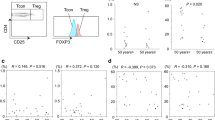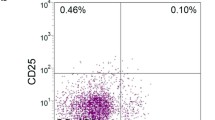Abstract
High-dose chemotherapy with autologous hematopoietic stem-cell transplantation (AHSCT) causes severe and long-lasting immunodeficiency in patients with lymphoproliferative disorders. The thymus begins to restore the T-cell repertoire approximately from the sixth month post-transplant. We assessed the dynamics of post-transplant recovery of CD4+CD45RA+CD31+ T cells, “recent thymic emigrants” (RTEs), and a poorly described subtype of CD4+CD45RA−CD31+ T cells in 90 patients with lymphoproliferative disorders following high-dose chemotherapy with AHSCT. Relative and absolute counts of CD4+CD31+ naïve and memory T cells were evaluated before AHSCT, at the day of engraftment, and 6- and 12-month post-transplant. The pre-transplant count of CD4+CD45RA+CD31+ T cells was lower than in healthy controls, and did not reach donors’ values during the 12-month period. The pre-transplant number of CD4+CD45RA–CD31+ T cells was higher than in healthy controls and was restored rapidly following AHSCT. Post-transplant mediastinal radiotherapy reduced counts of RTEs and elongated recovery period. Non-thymic tissue irradiation did not reduce this subset. The obtained data indicate that homeostatic proliferation may decrease the significance of CD31 expression on CD4+CD45RA+ T cells as a marker of RTEs, and suggest that evaluation of RTEs recovery by flow cytometry requires an accurate gating strategy to exclude CD31+ memory T cells.




Similar content being viewed by others
References
Borg C, Ray-Coquard I, Philip I, Clapisson G, Bendriss-Vermare N, Menetrier-Caux C, et al. CD4 lymphopenia as a risk factor for febrile neutropenia and early death after cytotoxic chemotherapy in adult patients with cancer. Cancer. 2004;101:2675–80.
Mackall CL, Hakim FT, Gress RE. Restoration of T-cell homeostasis after T-cell depletion. Semin Immunol. 1997;9:339–46.
Hazenberg MD, Verschuren MC, Hamann D, Miedema F, van Dongen JJ. T cell receptor excision circles as markers for recent thymic emigrants: basic aspects, technical approach, and guidelines for interpretation. J Mol Med (Berlin). 2001;79:631–40.
Kohler S, Thiel A. Life after the thymus: CD31+ and CD31− human naive CD4+ T-cell subsets. Blood. 2009;113:769–74.
Junge S, Kloeckener-Gruissem B, Zufferey R, Keisker A, Salgo B, Fauchere JC, et al. Correlation between recent thymic emigrants and CD31+ (PECAM-1) CD4+ T cells in normal individuals during aging and in lymphopenic children. Eur J Immunol. 2007;37:3270–80.
Azevedo RI, Soares MVD, Barata JT, Tendeiro R, Serra-Caetano A, Victorino RM, et al. IL-7 sustains CD31 expression in human naive CD4+ T cells and preferentially expands the CD31+ subset in a PI3K-dependent manner. Blood. 2009;113:2999–3007.
Chu Y-W, Memon SA, Sharrow SO, Hakim FT, Eckhaus M, Lucas PJ, et al. Exogenous IL-7 increases recent thymic emigrants in peripheral lymphoid tissue without enhanced thymic function. Blood. 2004;104:1110–9.
Thiel A, Alexander T, Schmidt CA, Przybylski GK, Kimmig S, Kohler S, et al. Direct assessment of thymic reactivation after autologous stem cell transplantation. Acta Haematol. 2008;119:22–7.
Matsuoka K, Kim HT, McDonough S, Bascug G, Warshauer B, Koreth J, et al. Altered regulatory T cell homeostasis in patients with CD4+ lymphopenia following allogeneic hematopoietic stem cell transplantation. J Clin Invest. 2010;120:1479–93.
Ringhoffer S, Rojewski M, Döhner H, Bunjes D, Ringhoffer M. T-cell reconstitution after allogeneic stem cell transplantation: assessment by measurement of the sjTREC/βTREC ratio and thymic naive T cells. Haematologica. 2013;98:1600–8.
Kimmig S, Przybylski GK, Schmidt CA, Laurisch K, Möwes B, Radbruch A, et al. Two subsets of naive T helper cells with distinct T cell receptor excision circle content in human adult peripheral blood. J Exp Med. 2002;195:789–94.
Ruiz-Hernandez R, Jou A, Cabrera C, Noukwe F, deHaro J, Borras F, et al. Distribution of CD31 on CD4 T-cells from cord blood, peripheral blood and tonsil at different stages of differentiation. Open Immunol J. 2010;3:19–26.
Batorov EV, Blinova EA, Tikhonova MA, Lopatnikova YA, Kryuchkova IV, Batorova DS, et al. Relationship between clinical factors and functional activity of the thymus in patients with hematological malignancies. Gematologiya i transfusiologiya. 2014;59:16–21 In Russian.
Nausch N, Bourke CD, Appleby LJ, Rujeni N, Lantz O, Trottein F, et al. Proportions of CD4+ memory T cells are altered in individuals chronically infected with Schistosoma haematobium. Sci Rep. 2012;. doi:10.1038/srep00472.
Koukourakis GV, Zabatis H, Zacharias GA, Koukourakis MJ. Post-surgical irradiation causes cellular immune suppression in patients with breast cancer. Eur J Cancer Care Engl. 2009;18:306–12.
Mellios T, Ko HL, Beuth J. Impact of adjuvant chemo- and radiotherapy on the cellular immune system of breast cancer patients. In Vivo (Brooklyn). 2010;24:227–30.
Alexander T, Thiel A, Rosen O, Massenkeil G, Sattler A, Kohler S, et al. Depletion of autoreactive immunologic memory followed by autologous hematopoietic stem cell transplantation in patients with refractory SLE induces long-term remission through de novo generation of a juvenile and tolerant immune system. Blood. 2009;113:214–23.
Pellier I, Renier G, Rakotonjanahary J, Audrain M, Berardi E, Gardembas M, et al. Long-term consequences of Hodgkin lymphoma therapy on T-cell lymphopoiesis. J Allergy Clin Immunol. 2015;135(818–20):e4.
Yovino S, Kleinberg L, Grossman SA, Narayanan M, Ford E. The etiology of treatment-related lymphopenia in patients with malignant gliomas: modeling radiation dose to circulating lymphocytes explains clinical observations and suggests methods of modifying the impact of radiation on immune cells. Cancer Invest. 2013;31:140–4.
Pugh JL, Sukhina AS, Seed TM, Manley NR, Sempowski GD, van den Brink MR, et al. Histone deacetylation critically determines T cell subset radiosensitivity. J Immunol. 2014;193:1451–8.
Nakamura N, Kusunoki Y, Akiyama M. Radiosensitivity of CD4 or CD8 positive human T-lymphocytes by an in vitro colony formation assay. Radiat Res. 1990;123:224–7.
Fornasa G, Groyer E, Clement M, Dimitrov J, Compain C, Gaston AT, et al. TCR stimulation drives cleavage and shedding of the ITIM receptor CD31. J Immunol. 2010;184:5485–92.
Acknowledgements
We are very grateful to the patients in the current study. The authors would like to thank the nurses at our institution.
Author information
Authors and Affiliations
Corresponding author
Ethics declarations
Conflicts of interests
The authors report no conflicts of interest. The authors alone are responsible for the content and writing of the paper.
About this article
Cite this article
Batorov, E.V., Tikhonova, M.A., Kryuchkova, I.V. et al. CD4+ memory T cells retain surface expression of CD31 independently of thymic function in patients with lymphoproliferative disorders following autologous hematopoietic stem-cell transplantation. Int J Hematol 106, 108–115 (2017). https://doi.org/10.1007/s12185-017-2214-4
Received:
Revised:
Accepted:
Published:
Issue Date:
DOI: https://doi.org/10.1007/s12185-017-2214-4




